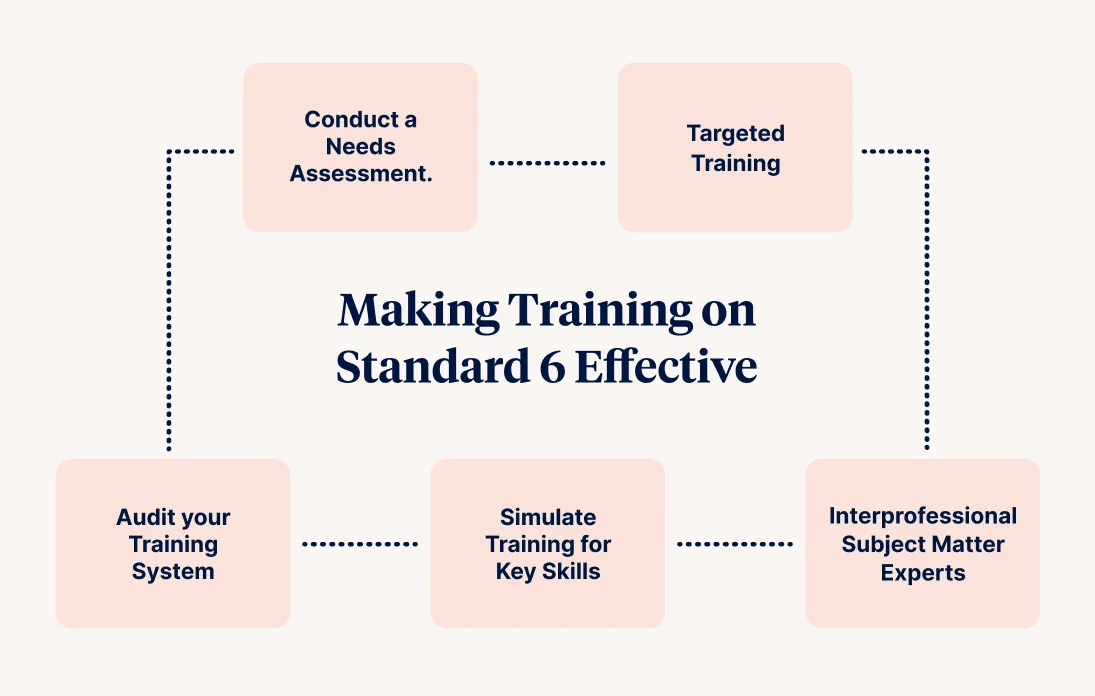Understanding the Intent and Expectations
Standard 6 of the strengthened aged care quality standards, Food and Nutrition, is focused on upholding the fundamental right of older people to access nutritious, appetising, culturally appropriate food and drinks aligned with individual preferences. It applies specifically to registered providers of residential aged care services. It draws on other key standards, especially Standards 3 (Care and Services) and 5 (Clinical Care), to ensure holistic, safe, and enjoyable mealtime experiences.
What Training Is Required and Why?
Workforce education plays a critical role in achieving these outcomes. Providers must ensure that their staff understand nutritional principles, culturally safe dining practices, and how to assess and respond to risks like malnutrition, dehydration, or choking hazards.
Key Training and Capability Requirements
Standard 6 identifies the following outcomes and associated workforce responsibilities:
| Outcome | Training Requirements |
|---|---|
| 6.1: Partnering with individuals | Staff must be trained in respectful, rights-based communication to understand food preferences, cultural considerations, and dining experiences. |
| 6.2: Nutritional assessment | Workers must know how to assess nutritional needs, recognise malnutrition, and escalate concerns. Coordinating with allied health professionals (e.g., dietitians and speech pathologists) is essential. |
| 6.3: Provision of food and drinks | Hospitality and kitchen staff must understand nutrition for aging, food safety, texture modification, and hydration principles. Care staff must be able to assist with feeding safely. |
| 6.4: Dining experience | Workers must foster a positive, dignified environment that supports social inclusion, autonomy, and enjoyable mealtimes. |
Meeting the requirements of Standard 6 Food and Nutrition also relies on training on Standard 5 (e.g., managing dysphagia, hydration, and infections) and Standard 3 (e.g., person-centred care planning).
Core Topics to Include in Training
Key topics to provide training on relating to Standard 6 Food and Nutrition include:
- Nutrition for older people: Energy, protein, hydration, and meal quality.
- Cultural food preferences: Religious, spiritual and cultural dietary needs.
- Modified texture diets and mealtime safety: IDDSI framework and choking risk management.
- Malnutrition and dehydration: Assessment techniques and escalation procedures.
- Communication: Supporting people with dementia or cognitive impairment in mealtimes.
- Social and emotional aspects of eating: Training on loneliness, inclusion, and dining support.
Where relevant, staff should also receive education on trauma-aware, culturally safe care during mealtimes and basic hand hygiene or infection prevention and control.
Who Needs Training?
Training should be assigned based on the scope and relevance of an individual’s role.
| Staff Role | Training Focus |
|---|---|
| Care workers | Feeding assistance, choking response, identifying risk, and person-centred care to assist partners with individuals. |
| Registered and enrolled nurses | Malnutrition screening, clinical assessment, escalation of care or choking management. |
| Kitchen and hospitality staff | Food safety, cultural competence, menu planning, and texture modification. |
| Lifestyle staff | Social dining, inclusion, and mealtime enjoyment. |
| Managers and team leaders | Complaints handling related to food services, monitoring quality indicators. |
Contracted food service providers and agency workers must also complete induction and role-specific training.
Audit Expectations and Evidence
To demonstrate conformance with Standard 6 during an audit, providers must show that education and training efforts are planned, implemented, and evaluated and have a genuine impact on individuals' mealtime experiences.
The table below summarises the types of evidence auditors may request during an audit.
| Evidence Type | Examples |
|---|---|
| Documents and records | Policies (nutrition, safety), care plans, menus, meal charts, staff rosters, audits, risk assessments, feedback logs, incident data, and continuous improvement plans. |
| Governing body | Evidence of oversight, monitoring, use of evidence-based practice, and recent improvements. |
| Management feedback | Describes how they involve individuals, use dietitians/chefs, monitor satisfaction, develop menus, and ensure safe food practices and adequate staffing. |
| Worker feedback | How they support eating/drinking, respond to complaints, personalise dining, prepare special diets, and ensure safety. |
| Individual experience | Feedback on choice, satisfaction, timing, snacks, social dining, and support. |
| Observations | Dining experience, food quality, kitchen safety, staff support, individual engagement, and communication systems. |
| Care outcomes | Rates of unplanned weight loss as per the National Mandatory Quality Indicator program. |
Best Practice: Making Training on Standard 6 Effective

Here are five key tips to make training on Standard 6 Food and Nutrition effective:
- Conduct a needs assessment: Use complaints data, feedback, clinical incidents (e.g., choking, aspiration pneumonia), and malnutrition data from your Quality Indicator data to identify knowledge, skill or practice gaps.
- Targeted training: Assign training carefully by role and function to avoid a ‘spray and pray’ situation and ensure targeted learning aligned to job roles.
- Interprofessional subject matter experts: Involve dietitians and speech pathologists in providing training. They have a wealth of knowledge and expertise and can teach key concepts safely and according to contemporary evidence.
- Simulate training for key skills: Consider scheduling sessions that simulate feeding techniques, responding with first aid to choking events, and other incidents, such as dissatisfied individuals or a family making a complaint.
- Audit your training system: Track completion rates and participation, and gain feedback from staff on their training to evaluate effectiveness. Review training items and plans at least annually and update material regularly to ensure it reflects best practices.
Training to support Standard 6 is not just a kitchen matter; it’s a multidisciplinary priority for all staff involved in providing care. Ensuring your team is equipped to provide nutritious, safe, and enjoyable dining experiences will not only improve the quality of life for residents but also help your service confidently meet audit expectations under the strengthened standards and reduce complaints.
List of Ausmed Modules on Standard 6
The following modules from the Ausmed Library help you meet the education and training requirements of Standard 6.
Explore the full library here.



